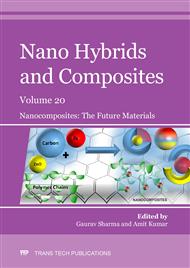[1]
R. Cammarata, Introduction to Nano Scale Science And Technology Springer Publishers, USA (2006).
Google Scholar
[2]
C.C. Okpala, Nanocomposites – An Overview International Journal of Engineering Research and Development, 8 (2013), 17-23, http://www.ijerd.com/paper/vol8- issue11/C08111723.pdf.
Google Scholar
[3]
Jean-Marie, Composite materials: mechanical behavior and structural analysis, mechanical engineering series, 2 (1998), 15.
Google Scholar
[4]
Leo Stander and Louis Theodore, Environmental Implications of Nanotechnology—An Update, Int. J. Environ. Res. Public Health, 8 (2011), 470-479.
DOI: 10.3390/ijerph8020470
Google Scholar
[5]
S.W. Khan, M. Ceylan, and R. Asmatulu, Effects of Nanotechnology on Global Warming, ASEE Midwest Section Conference, Rollo, MO, (2012),19-21.
Google Scholar
[6]
R. Asmatulu, W, S, Khan, R.J. Reddy and M. Ceylan, Synthesis and Analysis of Injection-Molded Nanocomposites of Recycled High-Density Polyethylene Incorporated with Graphene Nanoflakes, Polymer Composites, 36 (2015), 1565-1573.
DOI: 10.1002/pc.23063
Google Scholar
[7]
K. Buchholz, Nanocomposites Debuts On GM Vehicles Automotive Engineering International, (2003), http://www.sae.org/automag/material/10- 2001/index.htm.
Google Scholar
[8]
P. Shivani, Nanocomposites and it's application-review, http://www.academia.edu/3038972/Nanocomposites_and_its_Applications-Review.
Google Scholar
[9]
I.Y. Shevtsov, V.L. Markine, and C. Esveld, Optimal design of wheel profile for railway vehicles. Wear, 258 (7-8), 1022-1030.
DOI: 10.1016/j.wear.2004.03.051
Google Scholar
[10]
E. Thostenson, C. Li, and T. Chou, Review Nanocomposites in Context, Journal of Composites Science & Technology, 65 (2005), 491–516. (Reproduced in part with permission from Elsevier 2006.).
DOI: 10.1016/j.compscitech.2004.11.003
Google Scholar
[11]
D. Majumdar, T. N. Blanton, D.W. Schwark, Applied Clay Science, 23 (2003) 265– 273.
Google Scholar
[12]
L. Merhari, Hybrid Nanocomposites for Nanotechnology: Electronic, Optical, Magnetic and Biomedical Applications, Springer, Berlin, (2009), 231-287.
DOI: 10.1007/978-0-387-30428-1
Google Scholar
[13]
H. Wan, F. Delale, L. Shen, Effect of CNT length and CNT-matrix interphase in carbon nanotube (CNT) reinforced composites, Mechanics Research Communications, 32 (2005) 481–489.
DOI: 10.1016/j.mechrescom.2004.10.011
Google Scholar
[14]
J. H. Koo, Polymer Nanocomposites – processing, characterization and applications, McGraw-Hill, New York, (2006), 235-261.
Google Scholar
[15]
Y. Wang, X. Ma and B. Zhang, Preparation and properties of organoclay/polyethersulphone/epoxy hybrid nanocomposites, Polym. Compos., 36 (2015), 767–774.
DOI: 10.1002/pc.22998
Google Scholar
[16]
A.A. Gawad, A. M. K. Esawi and A.R. Ramadan,Structure and properties of nylon 6–clay nanocomposites: effect of temperature and reprocessing, J. Mater. Sci., (2010), 6677.
DOI: 10.1007/s10853-010-4760-5
Google Scholar
[17]
http://www.azom.com/article.aspx?ArticleID=936.
Google Scholar
[18]
http://www.azonano.com/article.aspx?ArticleID=2245.
Google Scholar
[19]
S. Sharma, S.K. Shashi and V. Tomar, Ceramic matrix composites with nano technology- An overview, International Review of Applied Engineering Research, 4 (2014), 99-102.
Google Scholar
[20]
H. Porwal, R. Saggar, Ceramic matrix nanocomposites, Reference module in material science and materials engineering.
Google Scholar
[21]
P.H.C. Camargo, K.G. Satyanarayana and F. Wypych, Nanocomposites: Synthesis, Structure, Properties and New Application Opportunities, Mater. Res., 12 (2009), 1-39.
DOI: 10.1590/s1516-14392009000100002
Google Scholar
[22]
R. Casati, M. Vedani, Metal Matrix Composites Reinforced by Nano-Particles—A Review, Metals - Open Access Metallurgy Journal 4 (2014), 65-83.
DOI: 10.3390/met4010065
Google Scholar
[23]
D.J. Branagan, D.E. In: Alman and J.W, editors. Powder metallurgy, particulate materilas for industrial applications, St.Louis: TMS Publication; (2000).
Google Scholar
[24]
D.J. Branagan, Y. Tang. Developing extreme hardness (>15 GPa) in iron based nanocomposites. Composites Part A – Applied Science and manufacturing. (2002); 33(6), 855-859.
DOI: 10.1016/s1359-835x(02)00028-3
Google Scholar
[25]
H.Cox, et al., Nanocomposite Systems for Automotive Applications,, Presented at 4th World Congress in Nanocomposites, EMC, San Francisco, 1-3 (2004).
Google Scholar
[26]
K. Müller, E. Bugnicourt, M. Latorre et al., Review on the Processing and Properties of Polymer Nanocomposites and Nanocoatings and Their Applications in the Packaging, Automotive and Solar Energy Fields, Nanomaterials (Basel). (2017) 7(4): 74.
DOI: 10.3390/nano7040074
Google Scholar
[27]
http://www.azonano.com/article.aspx?ArticleID=3258.
Google Scholar
[28]
J. Njuguna, K. Pielichowski, Polymer Nanocomposites for Aerospace Applications: Properties.
Google Scholar
[29]
http://what-when-how.com/nanoscience-and-nanotechnology/aerospace-applications-for-epoxy-layered-silicate-nanocomposites-part-1-nanotechnology.
Google Scholar
[30]
https://en.wikipedia.org/wiki/Metal_matrix_composite.
Google Scholar
[31]
P. Palmero, Structural Ceramic Nanocomposites: A Review of Properties and Powders' Synthesis Methods, Nanomaterials (Basel). (2015), 5(2), 656–696.
DOI: 10.3390/nano5020656
Google Scholar
[32]
R.M. Wang, S.R. Zheng and Y.P. Zheng, Introduction to polymer matrix composites, polymer matrix composites and technology, 1-25. https://www.elsevier.com/__data/assets/pdf_file/0011/87176/Polymer-Matrix-Composites-and-Technology_Intro_Excerpt.pdf.
DOI: 10.1533/9780857092229.1
Google Scholar
[33]
L.M. Manocha, J. Valand, N. Patel et al., Nanocomposite for applications, Indian Journal of Pure & Applied physics, 44 (2006), 135-142.
Google Scholar
[34]
E.T. Thostenson, Z. Ren, T.W. Chou, Advances in the science and technology of carbon nanotubes and their composites: a review. Composites Science & Technology. (2001), 61(13), 1899-(1912).
DOI: 10.1016/s0266-3538(01)00094-x
Google Scholar
[35]
J. Ning, J. Zhang, Y. Pan et al., Fabrication and mechanical properties of SiO2 matrix composites reinforced by carbon nanotube. Materials Science and Engineering: A-Structural Materials Properties Microstructure and Processing. (2003).
DOI: 10.1016/s0921-5093(03)00256-9
Google Scholar
[36]
M.H. Nazari, X. Shi, Polymer-Based Nanocomposite Coatings for Anticorrosion Applications, Industrial Applications for Intelligent Polymers and Coatings, (2016), 373-398.
DOI: 10.1007/978-3-319-26893-4_18
Google Scholar
[37]
D.R. Paul, L.M. Robeson, Polymer nanotechnology: Nanocomposites, Polymer, 49, 3187-3204.
DOI: 10.1016/j.polymer.2008.04.017
Google Scholar


